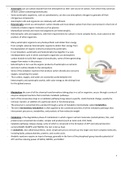Class notes
Biochemistry - Glycolysis
- Course
- Biochemistry
- Institution
- University Of Ottawa (U Of O )
These notes will be very helpful for anyone who needs help with Biochemistry note making or studying. They are very precise, but contain all the points you should know about this topic. So, you can use these notes as your class notes, as well as your summaries. Hope you guys will love these !
[Show more]



